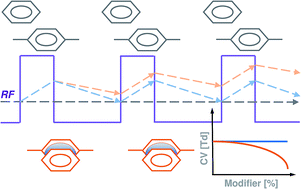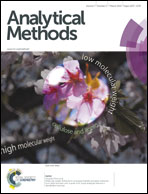Non-polar modifier assisted analysis of aromatic compounds by means of planar differential ion mobility spectrometry with a 63Ni ionization source†
Abstract
In this paper we demonstrate that the choice of an appropriate non-polar modifier which can provide sufficient chemical interactions with the target analytes may lead to the improvement of the selectivity and sensitivity of differential ion mobility spectrometric (DMS) methods. The influence of the aromatic modifier (benzene) on the DMS sensitivity and separation ability was proven using examples of five aromatic compounds (toluene, ethylbenzene, p-xylene, 1,2,4-trimethylbenzene (TMB), and naphthalene). These compounds can provide the π–π interaction with the chosen modifier. The influence of the modifier concentration on the compensation voltage, peak area, and peak width was investigated and discussed. The peak capacity for the mixture of toluene, ethylbenzene, p-xylene, TMB, and naphthalene was increased by about four times when the concentration of the benzene in the carrier gas was 0.09%. The strong influence of the proton affinity of analytes on the peak area in the measurements with a modifier was demonstrated. The peak area of the compounds with low proton affinity (toluene, ethylbenzene) significantly decreases with the increase of the aromatic modifier concentration. However, the peak area of the compounds with high proton affinity was significantly increased when benzene was added to the carrier gas. When the concentration of benzene in the carrier gas was 0.4% the peak area of naphthalene was more than tripled and the peak area of TMB was almost doubled. The increase of the peak area in the DMS equipped with a 63Ni-ionization source was explained by the improved ion transport within the DMS filter region. This differs from the DMS equipped with the APPI-source, which demonstrates increased signal intensities in the presence of aromatic dopants due to the increased ionization efficiency of analytes. Despite the higher response of the DMS in the presence of an aromatic modifier, the limits of detection for calibrations without a modifier and with 0.015% of benzene are within the same range (14.2–99.9 and 10.6–89.5 ng L−1, for the calibration without and with the modifier, respectively). This originates mainly from a higher background signal caused by benzene and a benzene dimer.


 Please wait while we load your content...
Please wait while we load your content...